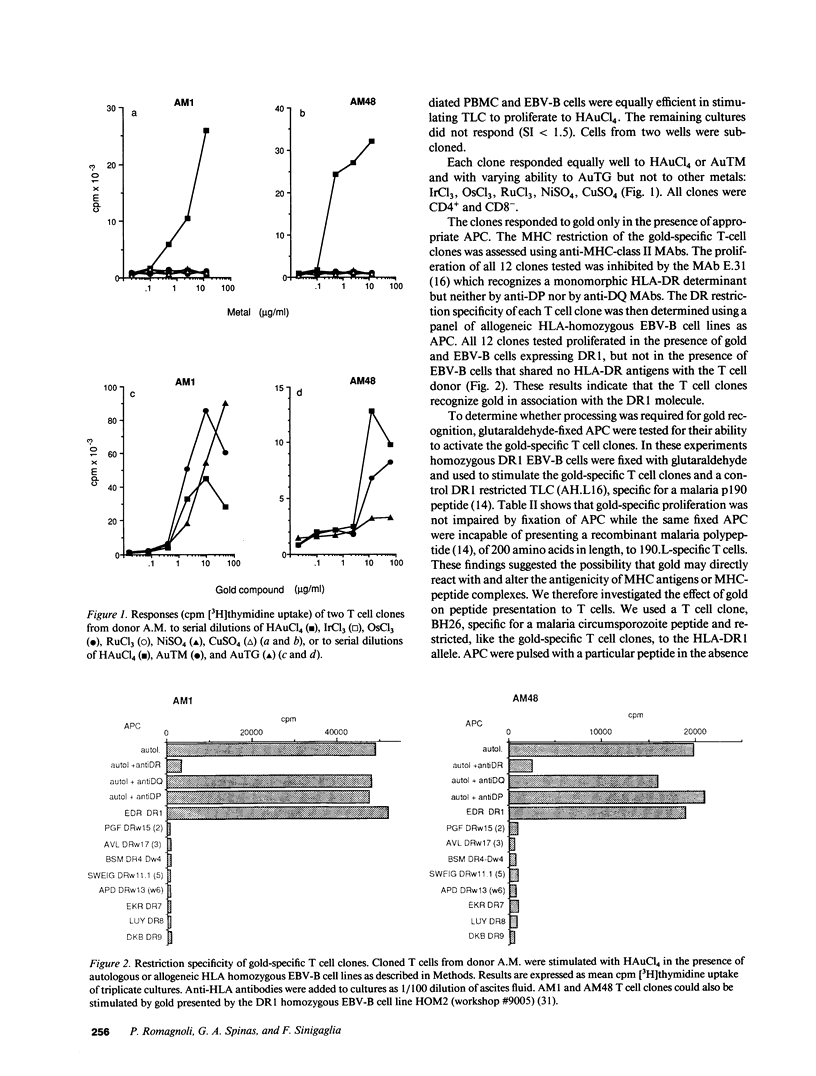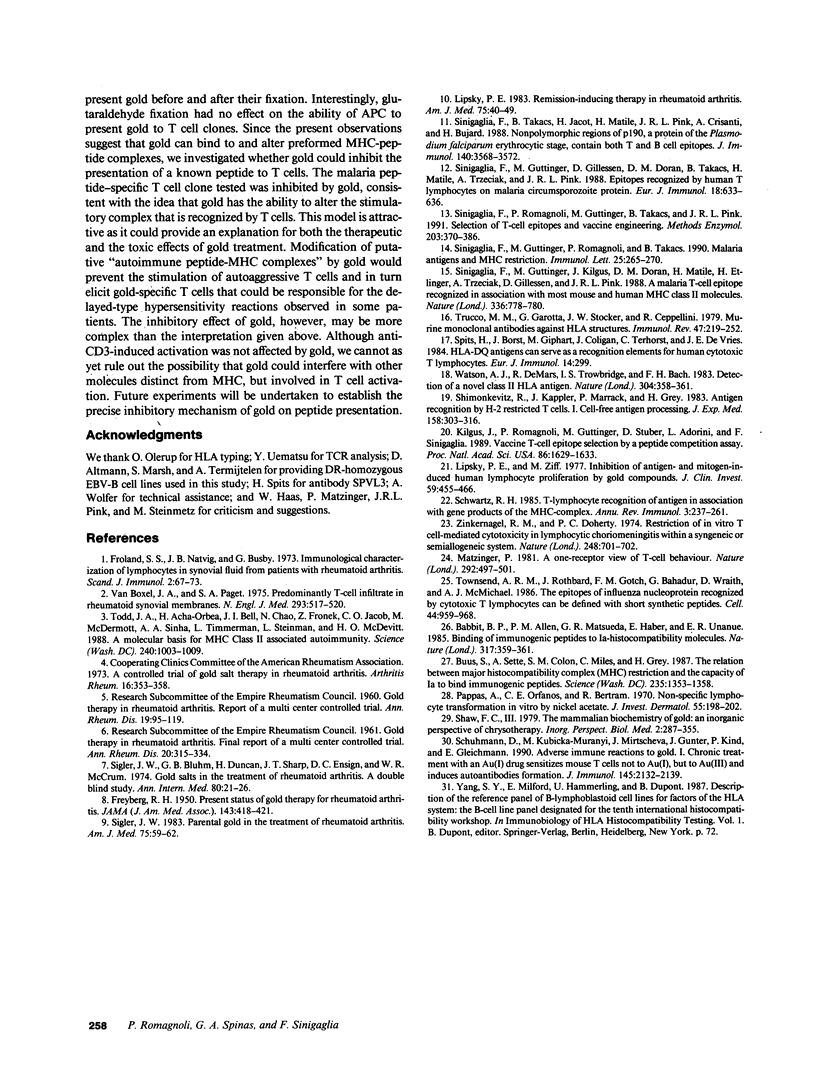Abstract
Gold-specific T lymphocyte clones were isolated from a patient with rheumatoid arthritis who developed delayed type hypersensitivity reactions to gold. All of the isolated T cell clones required histocompatible antigen presenting cells as well as gold for induction of proliferation. Using a panel of HLA-homozygous Epstein Barr virus-transformed B (EBV-B) cells and anti-HLA antibodies, the clones were shown to recognize gold in the context of DR1 molecules. Gold recognition did not require active antigen processing since specific proliferation was not affected by glutaraldehyde fixation of the DR1 homozygous antigen presenting cells. Furthermore, we could show that gold salts inhibited peptide-induced responses of a peptide-specific T cell clone. In addition to providing evidence for gold-specific T cells in gold-treated RA patients exhibiting delayed type hypersensitivity responses, these data suggest that gold can alter MHC-peptide complexes. The latter observation may in part explain the mechanism/s responsible for both the therapeutic and the toxic effects of gold.
Full text
PDF




Images in this article
Selected References
These references are in PubMed. This may not be the complete list of references from this article.
- Babbitt B. P., Allen P. M., Matsueda G., Haber E., Unanue E. R. Binding of immunogenic peptides to Ia histocompatibility molecules. 1985 Sep 26-Oct 2Nature. 317(6035):359–361. doi: 10.1038/317359a0. [DOI] [PubMed] [Google Scholar]
- Buus S., Sette A., Colon S. M., Miles C., Grey H. M. The relation between major histocompatibility complex (MHC) restriction and the capacity of Ia to bind immunogenic peptides. Science. 1987 Mar 13;235(4794):1353–1358. doi: 10.1126/science.2435001. [DOI] [PubMed] [Google Scholar]
- FREYBERG R. H. Present status of gold therapy for rheumatoid arthritis. J Am Med Assoc. 1950 Jun 3;143(5):418–421. doi: 10.1001/jama.1950.02910400010003. [DOI] [PubMed] [Google Scholar]
- Froland S. S., Natvig J. B., Husby G. Immunological characterization of lymphocytes in synovial fluid from patients with rheumatoid arthritis. Scand J Immunol. 1973;2(1):67–73. doi: 10.1111/j.1365-3083.1973.tb02017.x. [DOI] [PubMed] [Google Scholar]
- Kilgus J., Romagnoli P., Guttinger M., Stuber D., Adorini L., Sinigaglia F. Vaccine T-cell epitope selection by a peptide competition assay. Proc Natl Acad Sci U S A. 1989 Mar;86(5):1629–1633. doi: 10.1073/pnas.86.5.1629. [DOI] [PMC free article] [PubMed] [Google Scholar]
- Lipsky P. E. Remission-inducing therapy in rheumatoid arthritis. Am J Med. 1983 Oct 31;75(4B):40–49. doi: 10.1016/0002-9343(83)90327-3. [DOI] [PubMed] [Google Scholar]
- Lipsky P. E., Ziff M. Inhibition of antigen- and mitogen-induced human lymphocyte proliferation by gold compounds. J Clin Invest. 1977 Mar;59(3):455–466. doi: 10.1172/JCI108660. [DOI] [PMC free article] [PubMed] [Google Scholar]
- Matzinger P. A one-receptor view of T-cell behaviour. Nature. 1981 Aug 6;292(5823):497–501. doi: 10.1038/292497a0. [DOI] [PubMed] [Google Scholar]
- Pappas A., Orfanos C. E., Bertram R. Non-specific lymphocyte transformation in vitro by nickel acetate. A possible source of errors in lymphocyte transformation test (LLT). J Invest Dermatol. 1970 Sep;55(3):198–200. doi: 10.1111/1523-1747.ep12280705. [DOI] [PubMed] [Google Scholar]
- Schuhmann D., Kubicka-Muranyi M., Mirtschewa J., Günther J., Kind P., Gleichmann E. Adverse immune reactions to gold. I. Chronic treatment with an Au(I) drug sensitizes mouse T cells not to Au(I), but to Au(III) and induces autoantibody formation. J Immunol. 1990 Oct 1;145(7):2132–2139. [PubMed] [Google Scholar]
- Schwartz R. H. T-lymphocyte recognition of antigen in association with gene products of the major histocompatibility complex. Annu Rev Immunol. 1985;3:237–261. doi: 10.1146/annurev.iy.03.040185.001321. [DOI] [PubMed] [Google Scholar]
- Shimonkevitz R., Kappler J., Marrack P., Grey H. Antigen recognition by H-2-restricted T cells. I. Cell-free antigen processing. J Exp Med. 1983 Aug 1;158(2):303–316. doi: 10.1084/jem.158.2.303. [DOI] [PMC free article] [PubMed] [Google Scholar]
- Sigler J. W., Bluhm G. B., Duncan H., Sharp J. T., Ensign D. C., McCrum W. R. Gold salts in the treatment of rheumatoid arthritis. A double-blind study. Ann Intern Med. 1974 Jan;80(1):21–26. doi: 10.7326/0003-4819-80-1-21. [DOI] [PubMed] [Google Scholar]
- Sigler J. W. Parenteral gold in the treatment of rheumatoid arthritis. Am J Med. 1983 Dec 30;75(6A):59–62. doi: 10.1016/0002-9343(83)90475-8. [DOI] [PubMed] [Google Scholar]
- Sinigaglia F., Guttinger M., Gillessen D., Doran D. M., Takacs B., Matile H., Trzeciak A., Pink J. R. Epitopes recognized by human T lymphocytes on malaria circumsporozoite protein. Eur J Immunol. 1988 Apr;18(4):633–636. doi: 10.1002/eji.1830180422. [DOI] [PubMed] [Google Scholar]
- Sinigaglia F., Guttinger M., Kilgus J., Doran D. M., Matile H., Etlinger H., Trzeciak A., Gillessen D., Pink J. R. A malaria T-cell epitope recognized in association with most mouse and human MHC class II molecules. Nature. 1988 Dec 22;336(6201):778–780. doi: 10.1038/336778a0. [DOI] [PubMed] [Google Scholar]
- Sinigaglia F., Guttinger M., Romagnoli P., Takacs B. Malaria antigens and MHC restriction. Immunol Lett. 1990 Aug;25(1-3):265–270. doi: 10.1016/0165-2478(90)90125-a. [DOI] [PubMed] [Google Scholar]
- Sinigaglia F., Romagnoli P., Guttinger M., Takacs B., Pink J. R. Selection of T cell epitopes and vaccine engineering. Methods Enzymol. 1991;203:370–386. doi: 10.1016/0076-6879(91)03021-8. [DOI] [PubMed] [Google Scholar]
- Sinigaglia F., Takacs B., Jacot H., Matile H., Pink J. R., Crisanti A., Bujard H. Nonpolymorphic regions of p190, a protein of the Plasmodium falciparum erythrocytic stage, contain both T and B cell epitopes. J Immunol. 1988 May 15;140(10):3568–3572. [PubMed] [Google Scholar]
- Spits H., Borst J., Giphart M., Coligan J., Terhorst C., De Vries J. E. HLA-DC antigens can serve as recognition elements for human cytotoxic T lymphocytes. Eur J Immunol. 1984 Apr;14(4):299–304. doi: 10.1002/eji.1830140404. [DOI] [PubMed] [Google Scholar]
- Todd J. A., Acha-Orbea H., Bell J. I., Chao N., Fronek Z., Jacob C. O., McDermott M., Sinha A. A., Timmerman L., Steinman L. A molecular basis for MHC class II--associated autoimmunity. Science. 1988 May 20;240(4855):1003–1009. doi: 10.1126/science.3368786. [DOI] [PubMed] [Google Scholar]
- Townsend A. R., Rothbard J., Gotch F. M., Bahadur G., Wraith D., McMichael A. J. The epitopes of influenza nucleoprotein recognized by cytotoxic T lymphocytes can be defined with short synthetic peptides. Cell. 1986 Mar 28;44(6):959–968. doi: 10.1016/0092-8674(86)90019-x. [DOI] [PubMed] [Google Scholar]
- Trucco M. M., Garotta G., Stocker J. W., Ceppellini R. Murine monoclonal antibodies against HLA structures. Immunol Rev. 1979;47:219–252. doi: 10.1111/j.1600-065x.1979.tb00295.x. [DOI] [PubMed] [Google Scholar]
- Van Boxel J. A., Paget S. A. Predominantly T-cell infiltrate in rheumatoid synovial membranes. N Engl J Med. 1975 Sep 11;293(11):517–520. doi: 10.1056/NEJM197509112931101. [DOI] [PubMed] [Google Scholar]
- Watson A. J., DeMars R., Trowbridge I. S., Bach F. H. Detection of a novel human class II HLA antigen. 1983 Jul 28-Aug 3Nature. 304(5924):358–361. doi: 10.1038/304358a0. [DOI] [PubMed] [Google Scholar]
- Zinkernagel R. M., Doherty P. C. Restriction of in vitro T cell-mediated cytotoxicity in lymphocytic choriomeningitis within a syngeneic or semiallogeneic system. Nature. 1974 Apr 19;248(5450):701–702. doi: 10.1038/248701a0. [DOI] [PubMed] [Google Scholar]




